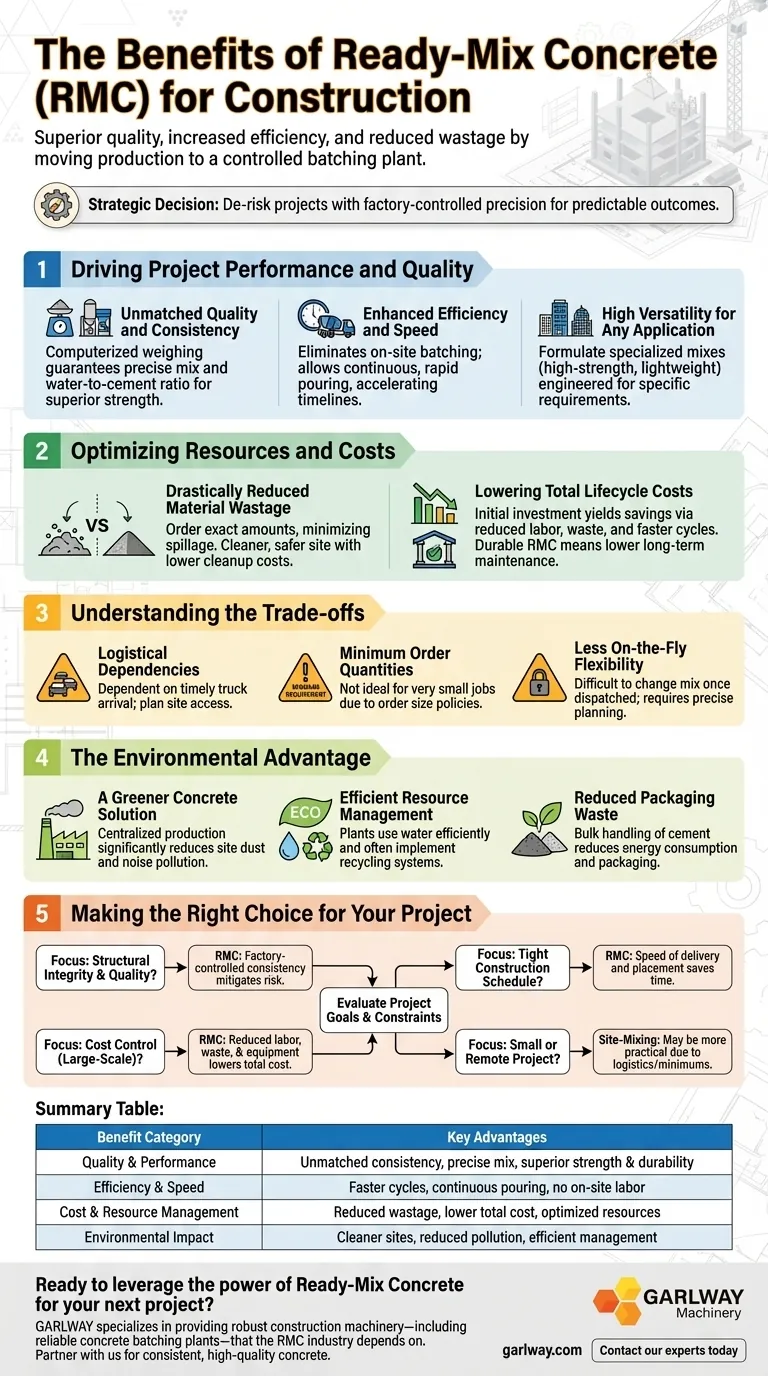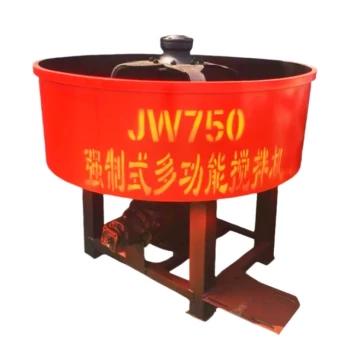The primary benefits of Ready-Mix Concrete (RMC) are a direct result of moving concrete production from the job site to a controlled, centralized batching plant. This shift delivers superior quality and consistency, increases the speed and efficiency of construction, and significantly reduces material wastage. It professionalizes a critical construction process, turning a variable task into a reliable, engineered product.
Choosing Ready-Mix Concrete is a strategic decision to de-risk a project. It replaces the uncertainties of on-site mixing with the precision of a factory-controlled process, leading to more predictable outcomes in quality, speed, and overall cost.

Driving Project Performance and Quality
The most significant impact of RMC is on the fundamental integrity and timeline of the construction project itself.
Unmatched Quality and Consistency
Unlike manual site mixing, RMC is produced in a batching plant using computerized controls. This ensures the precise weighing of cement, aggregates, and water for every batch.
This automated process guarantees a consistent water-to-cement ratio, which is the single most important factor determining the final strength and durability of the concrete.
Enhanced Efficiency and Speed
Using RMC eliminates the need for on-site material storage, batching equipment, and the labor required to operate it.
Concrete is delivered directly to the point of placement as needed, allowing for continuous and rapid pouring. This drastically accelerates project timelines, especially for large-volume pours.
High Versatility for Any Application
RMC plants can formulate a vast range of specialized concrete mixes that are difficult or impossible to produce reliably on-site.
This includes high-strength concrete, lightweight mixes, fiber-reinforced concrete, and other custom designs engineered for specific performance requirements.
Optimizing Resources and Costs
While the per-cubic-meter cost of RMC may seem higher at first glance, its true value is revealed in total project cost and resource management.
Drastically Reduced Material Wastage
The precision of plant-based batching means you order and use exactly the amount of material needed. This minimizes the spillage and excess of cement, sand, and aggregate common with on-site mixing.
Less on-site material handling also leads to a cleaner, safer, and more organized work environment with lower cleanup costs.
Lowering Total Lifecycle Costs
The initial investment in RMC pays dividends over the project's life. Savings are realized through reduced labor requirements, minimal material waste, and faster construction cycles.
Furthermore, the superior quality and durability of RMC lead to a longer-lasting structure with lower long-term maintenance and repair costs.
Understanding the Trade-offs
To make an informed decision, it is critical to recognize the logistical considerations inherent in using RMC.
Logistical Dependencies
The entire process is dependent on the timely arrival of concrete trucks. Site access must be planned, and traffic delays can impact the concrete's workability window.
Minimum Order Quantities
Most RMC suppliers have a minimum order size. For very small jobs or minor repair work, the cost and logistics may not be as favorable as mixing a small batch on-site.
Less On-the-Fly Flexibility
Once a truck is dispatched from the plant, it is difficult to make changes to the mix. This requires more precise planning and accurate volume calculations upfront.
The Environmental Advantage
Centralized production offers clear benefits for sustainability and environmental responsibility.
A Greener Concrete Solution
Moving production to a single plant location significantly reduces the dust and noise pollution generated at the construction site.
RMC plants can also manage resources like water more efficiently, often implementing recycling systems. Bulk handling of cement further reduces energy consumption and packaging waste.
Making the Right Choice for Your Project
To determine if RMC is the optimal choice, evaluate your project's primary goals and constraints.
- If your primary focus is structural integrity and quality assurance: RMC's factory-controlled consistency is the superior choice to mitigate risk.
- If your primary focus is a tight construction schedule: RMC's speed of delivery and placement provides a significant and reliable time-saving advantage.
- If your primary focus is cost control on a large-scale project: The reduction in labor, waste, and on-site equipment from RMC will almost always lead to a lower total project cost.
- If your primary focus is a small or highly remote project: The logistics and minimum order sizes of RMC may make carefully managed site-mixing a more practical alternative.
Ultimately, leveraging Ready-Mix Concrete empowers your team to transform a critical construction variable into a predictable and high-performing project asset.
Summary Table:
| Benefit Category | Key Advantages |
|---|---|
| Quality & Performance | Unmatched consistency, precise mix design, superior strength & durability |
| Efficiency & Speed | Faster construction cycles, continuous pouring, no on-site batching labor |
| Cost & Resource Management | Reduced material wastage, lower total project cost, optimized resource use |
| Environmental Impact | Cleaner sites, reduced pollution, efficient resource management |
Ready to leverage the power of Ready-Mix Concrete for your next project?
GARLWAY specializes in providing the robust construction machinery—including reliable concrete batching plants—that the RMC industry depends on. By partnering with us, you gain access to equipment that ensures the consistent, high-quality concrete your projects demand.
Contact our experts today to discuss how our solutions can help your construction company or contracting business achieve superior project outcomes with greater efficiency and cost control.
Visual Guide

Related Products
- HZS180 Ready Mix Concrete Plant for Foundations with Sand and Cement
- HZS120 Ready Mix Concrete Batching Plant Commercial Mud Cement Mixer
- Portable Concrete Mixer Machine Equipment for Mixing Concrete
- HZS75 Concrete Batching Plant Cement Mixer Price Concrete Mixer Bunnings Mixing Plant
- Hydraulic Concrete Mixer Machine Cement Mixing Equipment for Mixture Concrete
People Also Ask
- What are the factors influencing choice of a concrete mixing plant? Key Considerations for Efficiency
- What are the disadvantages of ready mix concrete? Navigating Logistical and Cost Challenges
- How much does a batching plant cost? Uncover the True Investment for Your Project
- What are the advantages of ready mix concrete? Higher Quality, Efficiency & Cost Savings
- How to make ready mix concrete stronger? Boost Strength with Proven Mixing Techniques















